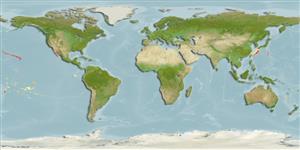>
Eupercaria/misc (Various families in series Eupercaria) >
Priacanthidae (Bigeyes or catalufas)
Etymology: Priacanthus: Greek, prion = saw + Greek, akantha = thorn (Ref. 45335).
Eponymy: Seth Eugene Meek (1859–1914) was an ichthyologist at the Field Museum of Natural History in Chicago. [...] (Ref. 128868), visit book page.
Environment: milieu / climate zone / depth range / distribution range
Écologie
marin récifal; non migrateur; profondeur 3 - 230 m (Ref. 38732). Tropical
Eastern Pacific: Hawaiian and Midway Islands; a single juvenile specimen recorded from the Galapagos Islands. Strays reach Johnston Atoll (Ref. 9710). Reports from Japan are probably misidentifications of Priacanthus hamrur.
Taille / Poids / Âge
Maturity: Lm ? range ? - ? cm
Max length : 33.0 cm TL mâle / non sexé; (Ref. 9710)
Inhabit clear lagoon and seaward reefs. Found under ledges during the day (Ref. 9710). Benthopelagic (Ref. 58302). Spawning may occur by December or soon after. Sound production has been studied in this species (Ref. 5403).
Life cycle and mating behavior
Maturité | Reproduction | Frai | Œufs | Fécondité | Larves
Starnes, W.C., 1988. Revision, phylogeny and biogeographic comments on the circumtropical marine percoid fish family Priacanthidae. Bull. Mar. Sci. 43(2):117-203. (Ref. 5403)
Statut dans la liste rouge de l'IUCN (Ref. 130435: Version 2024-1)
Menace pour l'homme
Harmless
Utilisations par l'homme
Pêcheries: pêcheries vivrières; Aquarium: Commercial
Outils
Articles particuliers
Télécharger en XML
Sources Internet
Estimates based on models
Preferred temperature (Ref.
123201): 18.7 - 23.1, mean 20.8 °C (based on 10 cells).
Phylogenetic diversity index (Ref.
82804): PD
50 = 0.5002 [Uniqueness, from 0.5 = low to 2.0 = high].
Bayesian length-weight: a=0.01698 (0.00734 - 0.03932), b=2.91 (2.72 - 3.10), in cm total length, based on LWR estimates for this (Sub)family-body shape (Ref.
93245).
Niveau trophique (Ref.
69278): 4.2 ±0.73 se; based on food items.
Résilience (Ref.
120179): Haut, temps minimum de doublement de population inférieur à 15 mois (Preliminary K or Fecundity.).
Fishing Vulnerability (Ref.
59153): Low vulnerability (23 of 100).
Nutrients (Ref.
124155): Calcium = 53.3 [34.5, 83.5] mg/100g; Iron = 0.729 [0.464, 1.097] mg/100g; Protein = 19.3 [18.2, 20.2] %; Omega3 = 0.185 [0.121, 0.280] g/100g; Selenium = 43.7 [26.0, 76.3] μg/100g; VitaminA = 105 [45, 255] μg/100g; Zinc = 0.942 [0.676, 1.292] mg/100g (wet weight);
